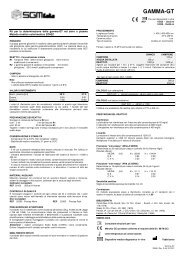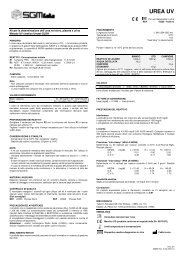CALCIUM CPC LR - Sgmitalia.com
CALCIUM CPC LR - Sgmitalia.com
CALCIUM CPC LR - Sgmitalia.com
You also want an ePaper? Increase the reach of your titles
YUMPU automatically turns print PDFs into web optimized ePapers that Google loves.
Kit for measurement of calcium in serum, plasma and urine<br />
Colorimetric o-cresolphtalein <strong>com</strong>plexone method <strong>CPC</strong><br />
PRINCIPLE<br />
O-cresolphtalein <strong>com</strong>plexone (<strong>CPC</strong>) reacts with calcium ions and magnesium at<br />
alkaline pH giving a strongly coloured <strong>com</strong>plex: the magnesium interference is<br />
inhibited by 8-hydroxyquinoline presence. The colour intensity is directly<br />
proportional to the calcium concentration in the tested sample.<br />
REAGENTS<br />
R1 AMP buffer pH 10.3 330.0 mmol/l<br />
R2 O-cresolphtalein <strong>com</strong>plexone 0.16 mmol/l; 8-hydroxyquinoline 9.0 mmol/l<br />
Calcium standard 10 mg/dl (2.50 mmol/l)<br />
SAMPLE<br />
- Serum or plasma. Diluted urine 1:5.<br />
Note<br />
- Do not use samples with haemolysis. Do not use anticoagulants as EDTA,<br />
oxalate, citrate or fluoride.<br />
- Avoid venous standstill. The use of tourniquet can rise the calcium level in the<br />
withdrawal in 0.5 mg/dl (0.12 mmol/l) as well.<br />
- After picked up, serum and plasma must be separated, as soon as possible,<br />
from red cells to avoid calcium absorption by red cells.<br />
- The calcium is stable in the serum or plasma 1 day at 2-8°C or 8 months at<br />
-20°C.<br />
- Serum strongly jaundiced or lipoemic must be tested using a blank sample.<br />
REFERENCE VALUES<br />
Serum Adults 8.5 - 10.8 mg/dl<br />
Serum Children 8.5 - 12 mg/dl<br />
Urine 100 - 300 mg/24h<br />
References values are considered indicatives since each laboratory should<br />
establish references ranges for its own patient’s population. The analytical results<br />
should be evaluated with other information <strong>com</strong>ing from patient’s clinical story.<br />
STORAGE AND STABILITY<br />
- Store the kit at 15-25°C. Do not freeze the reagents.<br />
- After opening, the vials R1, R2 and STD are stable up to the expiry date if<br />
recapped immediately and protected from contamination, evaporation, direct light,<br />
and stored at the correct temperature.<br />
- Working solution stability (R1+ R2): 6 hours at 15-25°C.<br />
PREPARATION OF REAGENTS<br />
Reagents are liquid and ready to use. About using as monoreagent (“samplestarter”<br />
procedure) mix the reagents R1 and R2 in equal parts.<br />
NOTE<br />
- The kit, according to this method, must be used in manual procedures. About<br />
automatic using follow specific applications.<br />
- Evaluate carefully the results if working reagent absorbance is > 0.500 at<br />
570 nm.<br />
- Avoid direct light, contamination and evaporation.<br />
- The volumes in the procedure can be changed proportionally.<br />
- In case of <strong>com</strong>plaint or quality control request, refer to the lot number on the<br />
package or the lot number on the singles vials.<br />
AUXILIARY EQUIPMENT<br />
Materials not included in the kit: diluent solutions, laboratory glassware,<br />
disposable tips, photometers and calibrators.<br />
QUALITY CONTROLS<br />
It’s necessary, every time the kit is used, to make the quality controls and to check<br />
that values obtained are within the acceptance range provided in the insert.<br />
Suggested serum:<br />
REF 20350 Precise Norm REF 20360 Precise Path<br />
PRECAUTION IN USE<br />
The product is not classified as dangerous (DLg. N. 285 art. 28 l. n. 128/1998).<br />
The total concentration of <strong>com</strong>ponents is lower than the limits reported by 67/548<br />
and 88/379 CE Regulations (and following modifications) about classification,<br />
packaging and labelling of dangerous substances.<br />
However the reagent should be handled with caution, according to good laboratory<br />
practice.<br />
Caution: the reagents contain Sodium Azide (0.095%) as preservative. Avoid<br />
swallowing and contacting with skin, eyes and mucous membranes.<br />
WASTE MANAGEMENT<br />
Please refer to the local legal requirements.<br />
<strong>CALCIUM</strong> <strong>CPC</strong> <strong>LR</strong><br />
liquid reagent<br />
For in vitro medical device<br />
REF 10053 - 4x100 ml<br />
PROCEDURE<br />
Wavelength λ: 570 (550-590) nm<br />
Working temperature 37°C (15-25°C)<br />
Optical path 1 cm<br />
Reaction “end point” (increasing)<br />
- MONOREAGENT PROCEDURE “sample starter”<br />
BLANK STD SAMPLE<br />
WORKING REAGENT 1000 µl 1000 µl 1000 µl<br />
DISTILLED WATER 25 µl -- --<br />
SAMPLE -- -- 25 µl<br />
STANDARD -- 25 µl --<br />
Mix, then incubate for 5’ at 37°C (15-25°C). Measure the absorbance of the<br />
sample (EC) and standard (ESTD) against the reagent blank.<br />
- BIREAGENT PROCEDURE “R2 starter”<br />
BLANK STD SAMPLE<br />
REAGENT R1 500 µl 500 µl 500 µl<br />
DISTILLED WATER 25 µl -- --<br />
SAMPLE -- -- 25 µl<br />
STANDARD -- 25 µl --<br />
Mix, incubate at 15-25°C for 1’ and then add:<br />
REAGENT R2 500 µl 500 µl 500 µl<br />
Mix, then incubate for 5’ at 37°C (15-25°C). Measure the absorbance of the<br />
sample (EC) and standard (ESTD) against the reagent blank.<br />
CALCULATION<br />
Calcium [mg/dl] o [mmol/l] = EC/ESTD x Conc. STD<br />
Dluted urines: multiply the result for diluting factor.<br />
CONVERSION FACTOR<br />
Calcium [mg/dl] x 0.2495 = Calcium [mmol/l]<br />
Calcium [mg/dl] x 0.4990 = Calcium [mEq/l]<br />
ANALYTICAL PERFORMANCES<br />
The reagent performances are related to 37°C and 570 nm.<br />
Interferences<br />
Bilirubin does not interfere up to concentration of 40 mg/dl.<br />
Triglycerides do not interfere up to concentration of 2000 mg/dl.<br />
Hemoglobin does not interfere up to concentration of 500 mg/dl.<br />
Magnesium does not interfere up to concentration of 15 mg/dl.<br />
Ascorbate acid does not interfere up to concentration of 30 mg/dl.<br />
Linearity<br />
Reaction is linear between 1.5-15 mg/dl (0.37-3.74 mmol/l). Samples with values<br />
exceeding 15 mg/dl must be diluted with saline solution. Multiply, then, the result<br />
for diluting factor.<br />
“Intra-Assay” precision (within-Run)<br />
Determined on 30 samples for each control (L-N-H) (Low-Normal-High).<br />
Results:<br />
MEAN (mg/dl) L = 4.10 N = 8.50 H = 12.10<br />
S.D. 0.16 0.25 0.37<br />
C.V.% 4.00 2.94 3.04<br />
“Inter-Assay” precision (between-Run)<br />
Determined on 15 samples for each control (L-H-N) for 3 days.<br />
Results:<br />
MEAN (mg/dl) L = 3.57 N = 7.78 H = 12.22<br />
S.D. 0.17 0.20 0.43<br />
C.V.% 4.68 2.63 3.46<br />
Analytical sensitivity<br />
The test sensitivity in terms of detection limit is 1.5 mg/dl (0.37 mmol/l).<br />
Correlation<br />
A study based <strong>com</strong>paring this method with a similar method on 21 samples has<br />
given a correlating factor r = 0.89<br />
The urine performances are available on request.<br />
BIBLIOGRAPHY<br />
Ray Sarkar, B.C. et al., Anal. Bioch., 20,155, (1967).<br />
Barnett, R.N. et al., Amer. J. Clin. Oath., 59, 836, (1973).<br />
Kaplan, L.A., Pesce, A..J.: “Clinical Chemistry”, Mosby Ed. (1996).<br />
SYMBOLS<br />
Read instruction for use<br />
CE mark (requirement of 98/79 regulation)<br />
Storaging temperature limits<br />
In vitro medical device Producer<br />
Calcium <strong>CPC</strong> <strong>LR</strong><br />
30159 Rev. 2 of 2012/01
















